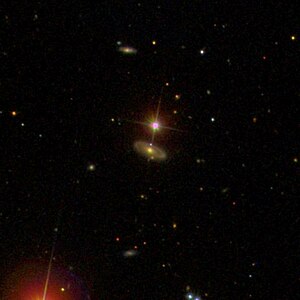NGC 2843
| Galaxy NGC 2843 |
|
|---|---|

|
|
| SDSS recording | |
| AladinLite | |
| Constellation | cancer |
|
Position equinox : J2000.0 , epoch : J2000.0 |
|
| Right ascension | 09 h 20 m 28.8 s |
| declination | + 18 ° 55 ′ 34 ″ |
| Appearance | |
| Morphological type | S0 |
| Brightness (visual) | 15.5 mag |
| Brightness (B-band) | 16.5 mag |
| Angular expansion | 0.4 ′ × 0.2 ′ |
| Position angle | 57 ° |
| Surface brightness | 12.6 mag / arcmin² |
| Physical data | |
| Redshift | 0.056778 +/- 0.000167 |
| Radial velocity | 17022 +/- 50 km / s |
|
Stroke distance v rad / H 0 |
(756 ± 53) x 10 6 ly (231.9 ± 16.2) Mpc |
| history | |
| discovery | William Herschel |
| Discovery date | March 21, 1784 |
| Catalog names | |
| NGC 2843 • PGC 26414 • 2MASX J09202879 + 1855346 • GC 1825 • H III 64 • 2MASS J09202877 + 1855344 • GALEX ASC J092028.60 + 185535.4 | |
NGC 2843 is a lenticular galaxy of Hubble type S0 in the constellation Cancer on the ecliptic . It is estimated to be 756 million light years from the Milky Way and about 90,000 light years in diameter.
The object was discovered on March 21, 1784 by the German-British astronomer Wilhelm Herschel .
